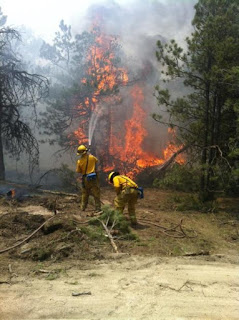“Unless we are willing to escape into sentimentality or fantasy, often the best we can do with catastrophes, even our own, is to find out exactly what happened and restore some of the missing parts.”
― Young Men and Fire
In the aftermath of Colorado's most destructive wildfire
By Rob Carrigan, robcarrigan1@gmail.com
I could see the black plume of smoke, up in the general direction of home, when I left the printer that early afternoon.
"Oh no," I thought to myself, "Not again."
The Black Forest Fire began near Highway 83 and Shoup Road in Black Forest, Colorado around 1 p.m. on June 11, 2013. When it was completely contained nearly ten days later, on June 20, 14,280 acres (22.31 square miles) were burned, at least 509 homes were said to be destroyed, and two people had died.
There was really no way to prepare for a heartbreaking trip touring the burn area on June 21, when they finally deemed it safe enough to let reporters in. Widespread devastation, twisted landscapes, disrupted service roads, and downed power lines — surrounded by the the charred remains of the forest and unrecognizable remnants of residents' dreams and promises. Many of the photos from that trip, I still struggle with viewing today.
Historically, this devastating fire leapfrogged over two other nearby fires I had covered as a newspaper guy, as the most destructive fire in the state's history, surpassing the 2012 Waldo Canyon Fire which also began near Colorado Springs, and the Hayman Fire, which began years earlier near Lake George.
The evacuation area covered 94,000 acres acres, 13,000 homes and 38,000 people. Three shelters were established in the area, including Elbert County Fairgrounds, which accepted humans, pets, and large animals. Two other shelters were designated for large animals only.
By June 13, nearly 500 firefighters were working the fireline, including agencies around the fire, the Colorado Air National Guard, and select personnel from fire suppression teams on Fort Carson and the nearby United States Air Force Academy. Governor John Hickenlooper addressed Emergency Managers at the command post on June 12. U.S. Northern Command assisted with fire fighting efforts.
“Probably most catastrophes end this way without an ending, the dead not
even knowing how they died...,those who loved them forever questioning
"this unnecessary death," and the rest of us tiring of this inconsolable
catastrophe and turning to the next one.”
― Young Men and Fire
― Young Men and Fire




















No comments:
Post a Comment